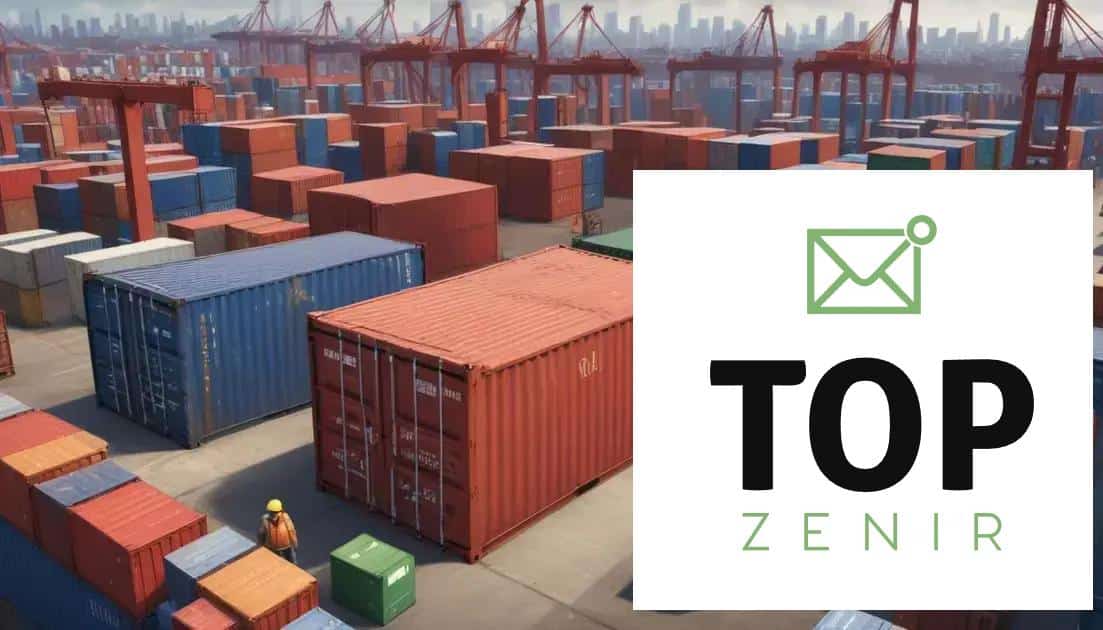Financial repercussions of the US-China trade conflict

The financial repercussions of the US-China trade conflict include reduced trade volumes, increased costs for consumers, and shifts in global market dynamics, significantly impacting both economies and international relations.
The financial repercussions of the US-China trade conflict continue to ripple through the global economy. Curious about how this tension affects your wallet and the broader market? Let’s dive in.
Understanding the US-China trade conflict
Understanding the US-China trade conflict is essential for grasping its effects on the global economy. This conflict has grown from complex trade practices and tariffs, affecting many aspects of international relations.
Background of the Trade Conflict
The trade discord began when the US accused China of unfair trade practices. These included stealing intellectual property and manipulating currency. As tensions rose, both countries imposed tariffs on each other’s goods, which escalated the situation further.
Key Causes of the Conflict
- Tariffs: Both nations placed tariffs on goods, making imports expensive.
- Trade Imbalance: The large trade deficit the US has with China sparked concerns.
- Technological Competition: The race for dominance in tech sectors heightened fears of competition.
- Geopolitical Tensions: Broader political relations have influenced trade decisions.
The consequences of this conflict are far-reaching, impacting not just the two nations involved but the entire world. For instance, manufacturers are reconsidering supply chains. Many are moving factories to other countries to avoid tariffs, which can lead to job losses in the US and China.
Retail prices have also increased due to tariffs on imported goods. Consumers may find familiar products at higher costs, which can strain household budgets. It’s clear that the US-China trade conflict reaches beyond politics, affecting everyday life.
Impact on Global Economy
This trade conflict has also caused uncertainty in global markets. Investors often be wary when the US and China clash, leading to stock market volatility. Companies must stay agile and responsive to changes, showcasing the importance of ongoing dialogue.
In conclusion, understanding the US-China trade conflict involves recognizing its causes and effects. The dynamic nature of trade relationships continues to evolve, influencing not just the involved nations but the global economy as a whole.
Economic impacts on American businesses

The economic impacts on American businesses due to the US-China trade conflict are significant and varied. Many companies must adapt to changes in tariffs and supply chains, which can create challenges as well as opportunities.
Changes in Tariffs
One of the main aspects of this trade conflict is the imposition of tariffs. Companies importing goods from China now face higher costs, forcing them to either absorb these costs or raise prices for consumers. This change can lead to decreased sales as customers look for cheaper alternatives.
Supply Chain Adjustments
The trade conflict has disrupted established supply chains. Businesses are considering alternative sources for products and materials. This shift can lead to:
- Higher Production Costs: Finding new suppliers may involve higher logistics costs.
- Increased Lead Times: New partnerships might slow down production as companies adjust.
- Risk Management: Diversifying suppliers reduces dependency on a single country.
Many American companies are now seeking to minimize risks by reshaping their supply chains. This could mean bringing manufacturing back to the U.S. or relocating factories to countries with fewer trade restrictions. On the downside, these shifts may impact jobs in sectors that depend on Chinese imports.
Moreover, American businesses that export goods to China also feel the pinch. Tariffs from China can make American products less competitive, decreasing market access. This situation might push companies to innovate and create products that better meet Chinese consumers’ needs.
Impact on Small Businesses
Small businesses often face unique challenges in adapting to the trade conflict. Many do not have the resources to quickly switch suppliers or absorb tariff costs. This can lead to
- Business Closures: Increased costs can push some small businesses out of the market.
- Market Uncertainty: Small businesses thrive on stability, and uncertainty can stifle growth.
In summary, the economic impacts on American businesses due to the US-China trade conflict highlight the need for adaptation and resilience. Companies that can pivot and innovate may find new opportunities even amidst challenges.
Effects on Chinese manufacturing and exports
The effects on Chinese manufacturing and exports as a result of the US-China trade conflict are profound and far-reaching. This conflict has reshaped how China approaches its production and market strategies.
Decline in Export Volumes
One of the most immediate impacts has been a decline in export volumes. American tariffs on Chinese goods have made many products more expensive in the US market. As a result, Chinese manufacturers see reduced orders for their products, leading to:
- Production Slowdowns: Factories may cut output to adjust for lower demand.
- Job Losses: Workers in the manufacturing sector may face layoffs as companies streamline operations.
- Financial Strain: Companies may struggle to cover costs without adequate sales.
Moreover, the decline in exports is not just limited to tariffs; it also includes a shift in consumer preferences. With rising prices, American consumers may turn to alternatives from other countries or domestically produced goods, further impacting China’s export economy.
Changes in Supply Chain Dynamics
The trade conflict has also forced Chinese manufacturers to rethink their supply chains. Many are seeking to reduce dependency on exports by focusing more on the domestic market. This shift can lead to:
- Increased Domestic Production: Manufacturers may produce more goods for local consumption.
- Investment in Technology: To stay competitive, businesses often need to innovate and upgrade technology.
- Diversification: Companies are looking for new markets beyond the US to sustain revenue.
In exploring alternative markets, Chinese manufacturers are finding growth opportunities in countries participating in the Belt and Road Initiative. This strategy opens new avenues to offset losses from US markets.
The trade conflict has sparked a transformation in the Chinese manufacturing landscape. As companies adapt, the focus is shifting toward sustainability, quality, and domestic demand. While challenges exist, the resilience of the Chinese manufacturing sector is evident as it pivots to meet new market dynamics.
Global market reactions to tariff changes

The global market reactions to tariff changes during the US-China trade conflict have been complex and significant. Investors and businesses closely monitor these changes as they can lead to immediate impacts on economies and stock markets worldwide.
Impact on Stock Markets
When tariffs are announced, stock markets often react quickly. The potential for increased costs can lower investor confidence. After a tariff announcement, market fluctuations can include:
- Increased Volatility: Prices of stocks can soar or plummet based on tariff news.
- Sectors Most Affected: Specific industries like technology and agriculture can experience more significant changes due to their reliance on trade with China.
- Global Index Changes: Tariff changes can affect indices like the S&P 500 or global equity indices, reflecting investor sentiment.
Investors tend to re-evaluate holdings, which may lead to selling off positions in companies vulnerable to higher tariffs. Over time, markets adjust as businesses strategize to deal with new economic realities.
Effects on Currency Exchange Rates
Tariff changes also influence currency exchange rates. When the US imposes tariffs, for example, the value of the dollar may fluctuate. A stronger dollar can occur, making American exports more expensive. In contrast, a weaker dollar could boost exports but also raise the cost of imports.
Countries affected by tariffs may respond with their own tariffs, which complicates the situation further. Trade partners might seek to protect their economies, leading to a cycle of escalating tariffs and counter-tariffs.
Furthermore, global supply chains are impacted as businesses reassess their operations. Companies look for ways to reduce costs, often considering relocating manufacturing to avoid tariffs, which can lead to shifts in labor markets and economic strategies worldwide.
Overall, the reactions of global markets to tariff changes highlight the interconnectedness of today’s economies. Each decision made on tariffs not only influences individual markets but also has the potential to create ripples across the globe.
Future outlook for US-China trade relations
The future outlook for US-China trade relations remains uncertain but is crucial for the global economy. As both nations navigate through their ongoing complexities, various factors will influence the direction of their trade relationship.
Potential Policy Changes
New policies could emerge that reshape trade agreements. Leadership changes in either country may bring fresh perspectives, potentially easing or heightening tensions. Trade negotiations may focus on:
- Tariff Reductions: Both countries might agree to lower tariffs to foster better business conditions.
- Intellectual Property Reforms: There may be efforts to address concerns around technology transfer and theft.
- Environmental Standards: Future agreements could include commitments to sustainability and fair trade practices.
The outcome of these negotiations will be pivotal. Improved relations could lead to increased trade volumes, benefiting both economies and the global market.
Shifts in Global Trade Dynamics
As the US and China reassess their trade practices, there are also shifts in global trade dynamics. Countries around the world are adjusting their strategies in response to the trade conflict. Emerging markets may find opportunities to fill the gaps created by tensions between the two major powers. Collaboration and trade agreements with other nations may become more attractive.
Moreover, businesses are increasingly looking for diversified supply chains to reduce risk. Companies may invest in production in countries outside of China or the US, leading to changes in manufacturing trends globally. This transition not only affects supply but also influences labor markets and economic growth in other regions.
Technological Competition
The race for technological supremacy continues to be a significant aspect of US-China relations. As both nations strive to lead in technology, the competition may intensify. This could lead to:
- Increased Investment in R&D: Both countries will likely invest more in research and development to gain a competitive edge.
- Collaboration on Global Issues: Issues like climate change may require cooperation, despite competition.
- Emerging Tech Alliances: Partnerships with other countries may become more strategic in tech development.
In summary, the future of US-China trade relations will depend on a combination of diplomatic efforts, global economic shifts, and the ongoing technological race. Observers must keep a close watch on developments as they unfold, understanding that these dynamics will shape not just the two nations, but the broader economic landscape.
FAQ – Frequently Asked Questions about US-China Trade Relations
What impact do tariffs have on US-China trade relations?
Tariffs can increase costs for businesses and consumers, often leading to reduced trade volumes between the two countries.
How does the trade conflict affect global markets?
The trade conflict creates uncertainty, causing fluctuations in stock markets and influencing global supply chains.
What are the future possibilities for US-China trade negotiations?
Future negotiations could focus on reducing tariffs, addressing intellectual property concerns, and enhancing cooperation on global issues.
How is technology competition influencing trade relations?
The race for technological supremacy adds pressure on both nations to protect their innovations and trade practices, affecting overall relations.





